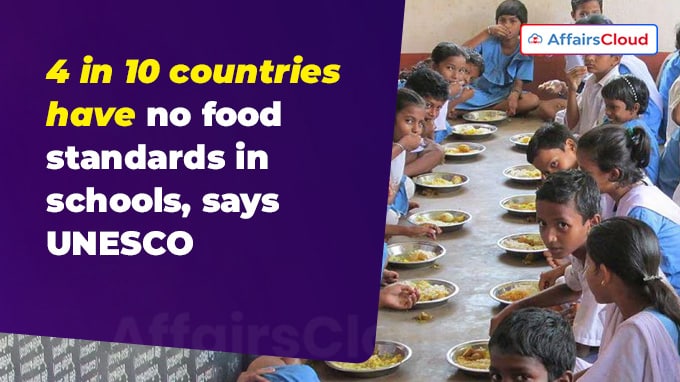 According to Paris (France)-based United Nations Educational, Scientific and Cultural Organisation (UNESCO)’s latest publication Global Education Monitoring (GEM) report, only 60% of countries have legislations or standards regulating food and beverages in schools, raises concerns over the global commitment to student health.
According to Paris (France)-based United Nations Educational, Scientific and Cultural Organisation (UNESCO)’s latest publication Global Education Monitoring (GEM) report, only 60% of countries have legislations or standards regulating food and beverages in schools, raises concerns over the global commitment to student health.
- The report was released in partnership with the Research Consortium for School Health and Nutrition, and is supported by the London School Hygiene and Tropical Medicine under the School Meal Coalition.
Key Findings:
i.The report showed that only 93 out of 187 countries have legislation, compulsory standards or norms on school food and beverages in school. It further revealed that only 29% of these countries have measures restricting food and beverage marketing in schools.
ii.The report highlighted that a survey-based assessment of school-based food and nutrition education in 30 low-and middle-income countries (LMICs) showed that integration within the school system was mostly conducted through extracurricular or project-based activities rather than as a standalone subject or across the curriculum.
iii.As per the report, only 3 out of 28 countries had conducted assessments at regular interval times and used that information which included changes in attitudes and perceptions about food and nutrition, knowledge, food practice, among others.
iv.Another survey centered around the school meal provision showed that 72% of countries reported some limitations on food marketing on school grounds and 52% had national-level restrictions on food permitted on or near school grounds.
India’s Initiatives:
i.India’s school meal programme, now called Pradhan Mantri Poshan Shakti Nirman (PM-POSHAN), was nationalized after a Supreme Court order in 2001. Children who received meals throughout primary school scored 18% higher in reading and 9% higher in math compared to those who received meals for only one year.
- Tamil Nadu pioneered school meals in 1925 and introduced a breakfast programme in 2022, increasing attendance from 60-70% to 90-95%.
ii.The Integrated Child Development Scheme (ICDS) provided protein-energy supplements, leading to a 9% higher likelihood of completing secondary school and 11% higher chance of finishing university for beneficiaries.
iii.Biofortified crops (like zinc wheat and iron pearl millet) were integrated into school meals in six states, with 20,000 farmers trained to grow and supply these grains.
Note*India is among countries where school meal coverage is higher in public schools.
Recent Related News:
UNSECO published its latest report titled ‘Education and Nutrition: Learn to Eat Well’, which focuses on the quality of meal served at schools worldwide. The report was released on the occasion of the ‘Nutrition for Growth (N4G)’, hosted by France from March 27 to March 28, 2025 in Paris (France).
- The report was prepared by UNSECO in partnership with the Research Consortium for School Health and Nutrition.
- The report revealed that nearly 50% of primary school pupils globally received school meals in 2024.




